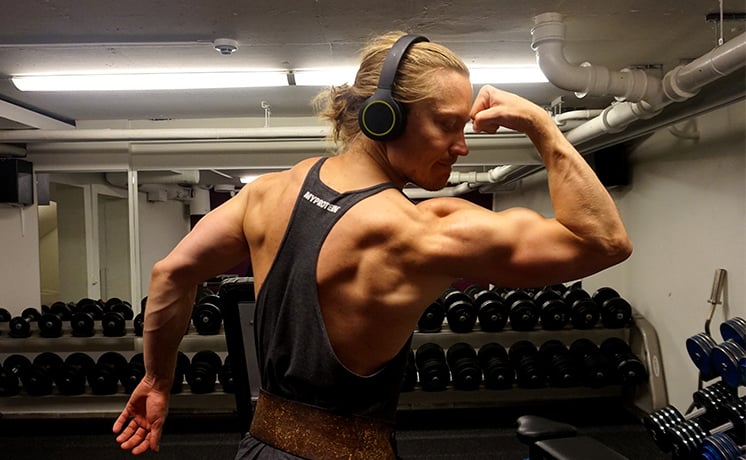
Over my years in the gym I’ve found that focusing on strength training in the low to medium repetition range (4-12 reps), with fairly long rest in between, is definitely the best approach when it comes to strength and muscle growth.
With that said though, you need a bit of pump training to fully complete your physique, especially for certain body parts that can’t be trained by lifting heavy, or simply requires more training to grow.
The pump training method that I’ve found work best, and that has helped me put the icing on the cake when it comes to building my physique is called: Myo reps!
In this post, or guide rather, I’ll cover everything you need to know about this awesome training method known as Myo reps, and how you can use it to fully develop your body to get that aesthetic looking Hollywood physique.
Let’s go.
Table of Contents
What Is Myo Reps?
Myo reps is a form of “rest pause” training popularized by Borge Fagerli from Norway. When performing the method you’re using a lighter weight, do a set close to failure and then take a brief pause between repetitions. We’ll look closer on how to do this in a moment.
Rest pause training isn’t something new as it’s been around since early 1946 and since then there’s been numerous variations, some of the most popular being Mike Mentzer’s version from High Intensity Training, and Dante Trudell’s “DoggCrapp” or DC-training method.
But, you’ll soon find out how Myo reps moves beyond simply taking a rest-pause between repetitions, and what makes it one of the most unique and effective training methods out there.
How to do Myo Reps
Okay, so before discussing the benefits of Myo reps, let’s first look at how Myo reps is done so you can get an idea of what it is and how it works.
Here’s a brief outline of how to do a set of Myo reps:
Example Myo-Reps Set
- Start by doing an activation set: Use a weight that you can get between 12-15 reps with. Then do as many reps as you can until you’re 1-2 repetitions away from failure.
- After the activation set, rest 10-15 seconds
- After the short rest do another set until you’re 1-2 reps away from failure.
- Then rest another 10-15 seconds
- Repeat this process until you no longer can get the same amount of reps on all your “minisets”, or after you’ve reached 5 sets in total (4 minisets).
To clarify, here’s a couple examples of successful Myo rep sets:
Example set 1:
- Activation set: 15 reps
- Miniset 1: 5 reps
- Miniset 2: 5 reps
- Miniset 3: 3 reps
- Stop
The reason why we’re stopping after 3 sets is because your fatigue is so high that you shouldn’t go on any longer. Sure you could possibly do 1 more miniset and get 1-3 reps, but that would likely be negative for your recovery. In fact, lost performance is an indicator that the muscles have had enough training, especially when training with higher reps.
So, stopping once you drop of in repetetitions works as a sort of autoregulation of your training volume, which basically means that you follow your recovery capacity. And I’ve found this to work incredibly well for building muscle quickly without burning out.
Example set 2:
- Activation set: 15 reps
- Miniset 1: 5 reps
- Miniset 2: 5 reps
- Miniset 3: 5 reps
- Miniset 4: 5 reps
- Stop
In this example we’re stopping once you’ve completed 5 sets with the same amount of reps on all sets. The reason why I choose to stop at 5 sets is because that’s enough training volume for most people to handle. Going much above this usually only leads to overtraining, especially if you’re also training with compound exercises before doing Myo reps (as you should).
So, as you can see, when doing Myo reps you take advantage of short rest periods to give you the same training stimulus in around two thirds of the time it would normally take you. While it also leaves you with an incredible pump that contribute to both myofibril and sarcoplasmic hypertrophy to ensure maximum muscle development. We’ll look closer at all the benefits of Myo reps soon.
Myo Reps vs Straight Sets: How Many Myo Sets Should I do?
One complete set of Myo reps provides you with a ton of training volume and intenisty. For this reason I always view one whole Myo rep set as roughly three straight sets.
So, three straight sets such as 3×12-15 with ~2 minutes of rest in between would be the same as 1 Myo rep set no matter how many minisets you manage to get.
The amount of Myo sets you should do in your workout would depend on the amount of training volume you need. But usually I would recommend no more than 1 Myo rep set per isolated muscle group. I discuss more in depth why and when to use Myo reps in a moment.
How to Make Progress With Myo Reps
One question I get a lot regarding Myo reps is how to make progress with the method. This is a great question to ask because no matter how much you train, if you’re not getting stronger over time then you won’t build any noticeable amounts of muscle mass. In other words, progressive overload is the name of the game even with Myo reps.
So, what’s the best way to make progressive overload using Myo reps then?
Well, by using double progression, here’s how:
How to do Double Progression With Myo Reps
- On your first activation set you work within a repetition range. For Myo reps I usually recommend 12-15 repetitions.
- When you reach the top repetition, which in this example would be 15 reps on all your sets, then you increase the weight with the smallest increment available on your next workout.
- With the increased weight, try to reach the top reps on all sets again during the upcoming workouts.
- Repeat this process until you no longer can increase weights using this progression model.
The small “minisets” that you do after your activation set is simply there to add training volume, but you only track your performance on the first activation set and make progress based on that set.
So, let’s say that you’re supposed to do Myo reps with 8 kg dumbbell lateral raises, and here’s how your workout goes:
- On your activation set you get 13 reps with 8 kg
Since you got 13 reps on your activation set this workout with 8 kg, you stay with 8 kg for the next workout:
- On the next workout you get 15 reps with 8 kg
Awesome, you now reached the top of the repetition range on your activation set. For the next workout you now increase the weight to 9 kg.
- On the next workout you get 12 reps with 9 kg
Now your goal is to increase your reps using 9 kg over the coming workouts until you reach 15 reps again. Rinse and repeat.
The Benefits of Using Myo Reps
Okay, so let’s get to the details behind why I believe Myo reps is such a good and effective method to use.
While it’s true that mechanical tension on the muscles, i.e. the load lifted is the primary driver of muscle growth, recent studies have provided a more nuanced picture of this. It looks like you can achieve a very strong signal for strength and muscle growth with less mechanical tension as well, as long as you expose all your muscle fibers to the work completely.
Basically this means that you can achieve maximum muscle fiber recruitment using lighter loads as well. This is done by compensating for the lack of loading by allowing the lighter load to do it’s work on the muscle for a longer time. And this is extremely useful during certain situations. Let’s look at some of these:
Extremely time effective
The power of Myo reps is that you can get this extra work required to grow with light weights in a much shorter time by manipulating rest periods.
Because of the short rest times, each “miniset” will have you work with repetitions that will cause muscle growth immediately.
Think of it this way, if you were to do 12 to 15 reps the standard way, meaning with 1 to 2 min rest in between. Then the first 8-10 reps of the exercise are going to be so easy that you would just go through the motion and get very little productive work from the time and movement invested, just as displayed under high reps/low load in this image:
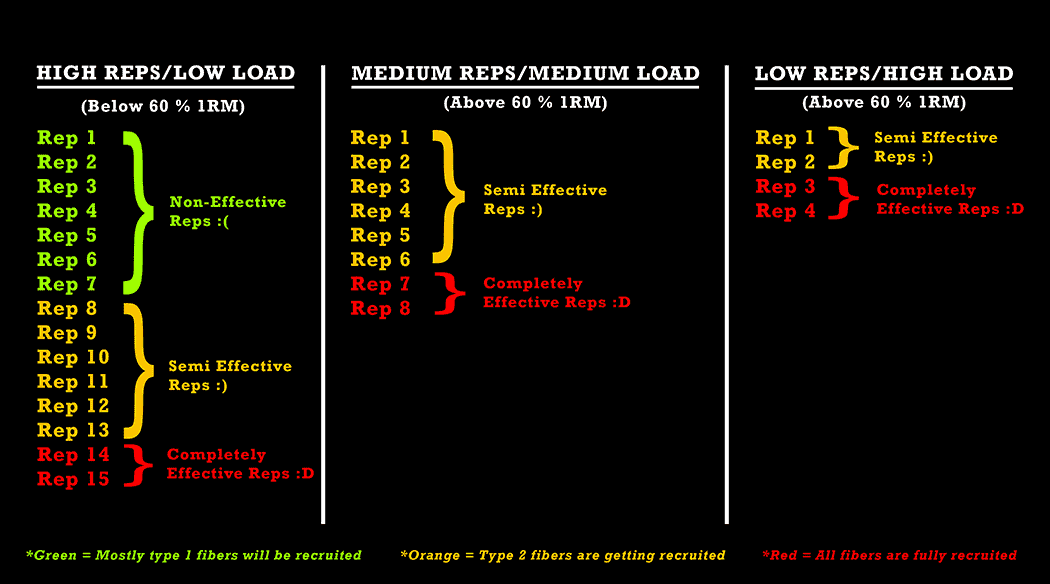
With Myo reps on the other hand, since you’re utilizing shorter rest periods, each “miniset” would be like starting on rep 8-10, meaning that immediately from the first rep you do effective work that causes muscle growth.
Provides muscle pump of gods

Another huge advantage of Myo reps is that it leads to amazing pump in the gym. But more importantly, this pump promotes something called “sarcoplasmic hypertrophy” more effectively than any other training method out there.
Sarcoplasmic hypertrophy is stored glycogen and fluids that gathers around the contractile muscle fibers. Doing Myo reps to achieve this kind of hypertrophy on top of your bread and butter strength training will lead to a maximized physique where you’ll look incredibly big and aesthetic.
Lighter weights are easier on joints & tendons
One of the biggest problems with a lot of moderate to heavy lifting is that it’s highly taxing on your joints and tendons. Training with Myo reps and lighter weights is a perfect way to work around creaky joints and tendons if you’d ever be unfortunate to fall into such problems.
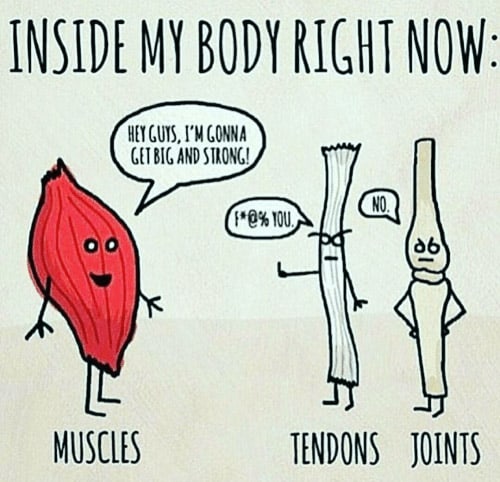 Furthermore Myo reps is especially powerful for certain muscle groups that can’t handle heavy weights very well, like your side delts for example. If you’d try to lift 4-8 reps on lateral raises for example, it wouldn’t take long until your joints would be in a world of pain.
Furthermore Myo reps is especially powerful for certain muscle groups that can’t handle heavy weights very well, like your side delts for example. If you’d try to lift 4-8 reps on lateral raises for example, it wouldn’t take long until your joints would be in a world of pain.
Myo reps is also a good method for muscle groups that need more training volume to grow, usually biceps and rear delts.
I believe that Myo reps is best used for smaller muscle groups that need more isolation to grow. This is because you want to increase volume only on the specific muscle that requires more training without overtaxing your other muscles, joints and tendons which gets heavily trained with compound strength training.
In other words, if you were to do more training with heavy compound lifts you’re at a much higher risk of overtraining, so picking isolation exercises and using Myo reps is a much better choice. Later I’ll cover which muscle groups and exercises I recommend to use in combination with Myo reps.
Less central fatiguing
Even though training with moderate to heavy weights in the medium to low rep range with longer rest times is the bread and butter for strength and muscle growth, it’s also very fatiguing to the central nervous system.
For this reason, if you need to add training volume for certain muscle groups, doing so with Myo reps using lighter weights is very smart as that will cause more local fatigue on the muscles that need more training without overtaxing your CNS.
Has a fat burning effect
This is a cool benefit of Myo reps. Essentially Myo reps is like HIIT cardio but with weights. When doing Myo you build up a lot of metabolic stress which requires your heart and lungs to work hard. To recover from this metabolic stress your body needs a lot of energy (calories) and hence that Myo has a fat burning effect. Which makes it a perfect training strategy when cutting.
Has a cardiovascular/conditioning effect
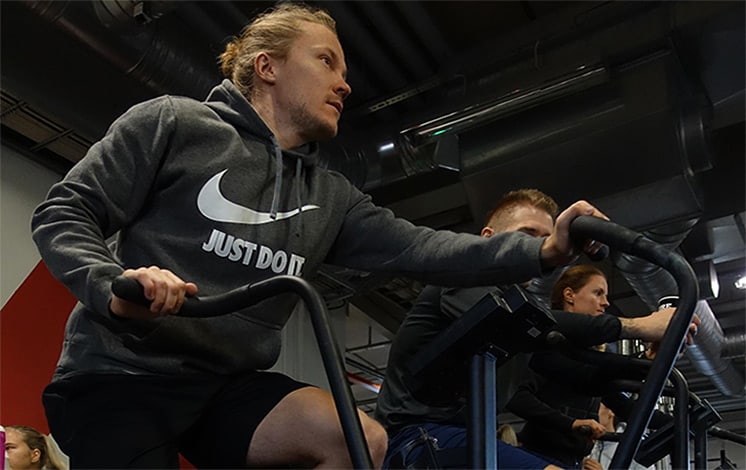
The fact that your heart and lungs need to work when doing Myo reps also leads to positive effects on your cardiovascular conditioning. So, implementing Myo reps can be viewed as a bit of free cardio!
In fact, since I started incorporate Myo reps in my training I’ve been able to step down my regular cardio a bit, while still maintaining most of my conditioning. So, if you dread cardio, then Myo reps are nice! 😉
It can “reactivate” muscle growth if you have stalled
This is a neat little benefit of Myo reps. If you’ve stalled in your bread and butter heavy lifting, then using Myo reps on that lift, or other exercises using the same muscle groups, then you could come back stronger and be able to move pass your plateau.
One of the reasons you might reach a plateau in your lifting is because of monotonous overtraining. Which according to Brad Schoenfeld is a maladaptation of the neuromuscular system that appears when you’re doing the same exercises in the same fashion for long periods of time.
If this happens, Myo reps can help you move pass your plateau by giving you a periodized effect, where you’re stepping of the training that are no longer working. This will have you do something completely different for a while, without actually removing the stimulus, you’re just providing a different one. I’ve found this to work very well when people stall on their main lifts.
Why And When to Use Myo Reps
One of the main reasons why I recommend using Myo reps is because it’s a very time effective and less centrally fatiguing way of adding training volume to certain areas of the body in order to develop optimal aesthetic proportions. And also as I just wrote, it improves your physical appearance by increasing sarcoplasmic hypertrophy.
With that said, I’m mainly using Myo reps on assistance exercises and for lighter weights. Lifting heavy weights with adequate rest in between sets on a few key compound lifts is definitely the best way to build the base of your physique.
However, myo reps is extremely effective for certain muscle groups that needs special attention in order to grow and help make up an aesthetic physique. And these muscle groups are:
- Medial delts
- Biceps
- Rear delts
- Abs (rectus abdominis)
- (For stalled muscle groups)
These muscle groups simply can’t be overlooked if you want to build an aesthetic and strong looking physique. So, let’s look at these muscle groups one by one and how Myo reps can help.
Myo Reps For Medial Delts
Your shoulders are arguably the most important muscle group to develop for an aesthetic appearance. Guys always want a big chest and biceps, but the fact is that nothing beats the aesthetics of a set of great 3D shoulders.
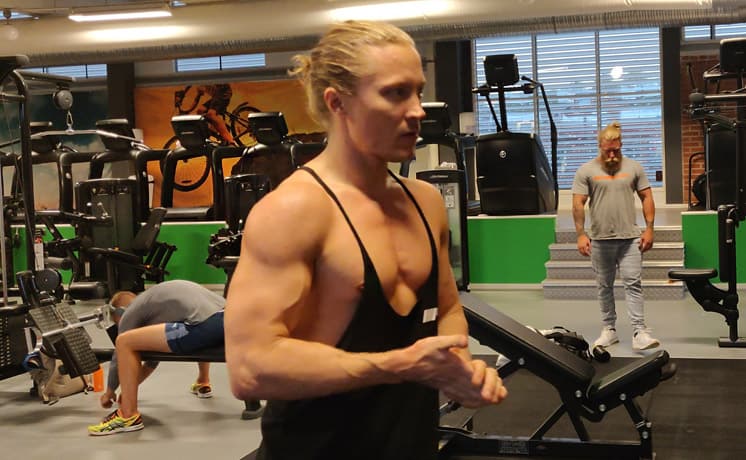
Your shoulders have three heads. The front delts, medial delts and read delts, and to build great looking 3D shoulders you need to develop all heads:
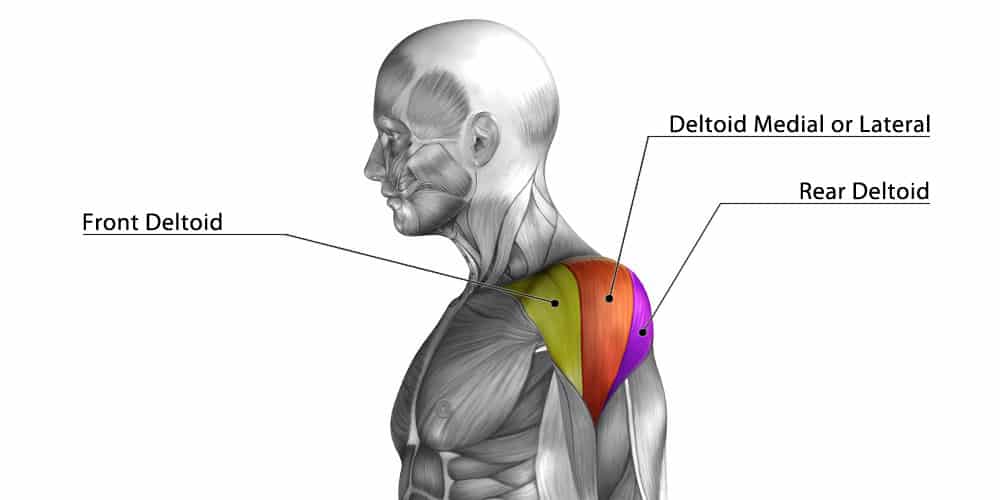
Both your front delts and rear delts get stimulated well enough from pushing and pulling exercises, but your medial delts do not. The problem with your medial delts is that they’re used in a certain way that don’t allow them to get hit effectively by any of your compound lifts, not even overhead presses hit you medial delts well enough.
The only way to effectively hit them is when you extend your arms out to the sides, like if you were standing with your side against a wall and pushing your arm against it.
This movement puts your shoulders in a very bad position to lift heavy weights, risking injury. For this reason, you need to use isolation exercises, with lighter weights and higher reps to train your side delts safely and effectively.
Furthermore, most people also find that their side delts are one of the more stubborn muscles to build up. So, using Myo reps is a very smart idea for quick, effective and sustainable growth of your side delts.
Best exercises for side delts:
Lateral raises
This is my absolute favorite exercise for side delts and it works very well together with Myo reps.
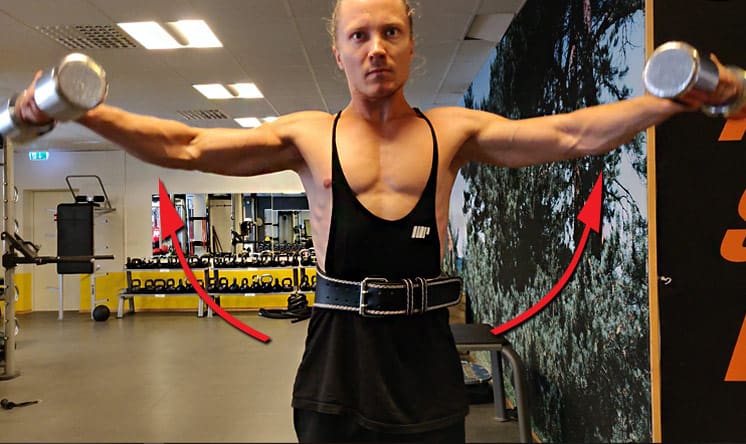
Upright rows
This is another great exercise for your side delts and works very well with Myo reps. However it’s more of a compound lift which means it taxes many other muscle groups, not only your side delts. Now, this is good in general but not for the purpose of isolating your side delts.
So, if you decide to use upright rows you need to take it easier on other upper body compound lifts such as overhead presses and rows. And this will reduce how effectively you’ll build your shoulders, back and traps. So, I recommend lateral raises above upright rows.
With that said though, if you simply enjoy upright rows more and program sensibly, then it’s a great exercise as well.
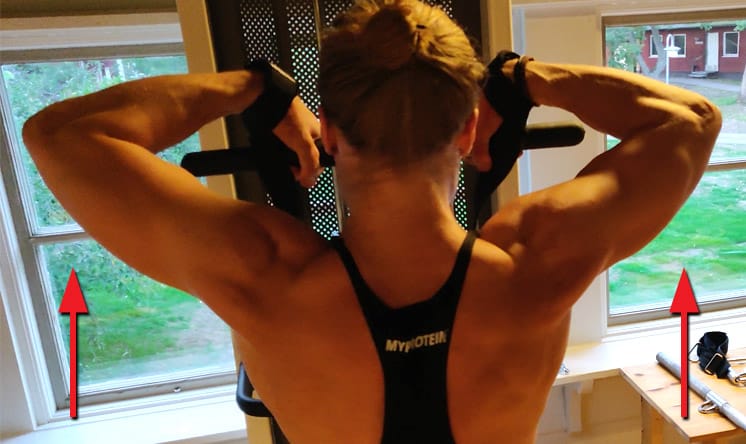
Myo Reps For Biceps & Rear Delts
Another reason for using isolation exercises are for certain muscle groups that requires a bit more volume to grow, and for most people biceps and rear delts fall under this category.
Well developed biceps and rear delts are also huge components of an aesthetic physique, so making sure they’re well-developed is very important.
Now, most people will get decent bicep and rear delt growth from compound lifts like pull-ups and rows. But to get very well-developed biceps and rear delts, these muscles usually requires a bit more work. The reason for this is that they’re very fatigue resistant by having a higher ratio of type 1 muscle fibers as opposed to type 2 muscle fibers.
And since type 1 muscle fibers have a harder time growing from heavy lifting, Myo reps becomes a perfect tool for making your biceps and rear delts grow quicker.
To avoid risking overtraining of other muscles included in compound lifts that target biceps and rear delts, such as the Lats, Rombs and Traps etc. I recommend performing Myo reps on the following exercises:
Best exercises for biceps and rear delts:
Spider curls:
This is a bicep isolation exercise that I absolutely love. It isolates your biceps very well and lends itself perfectly for Myo reps. Simply said, it causes an extreme pump in your biceps.
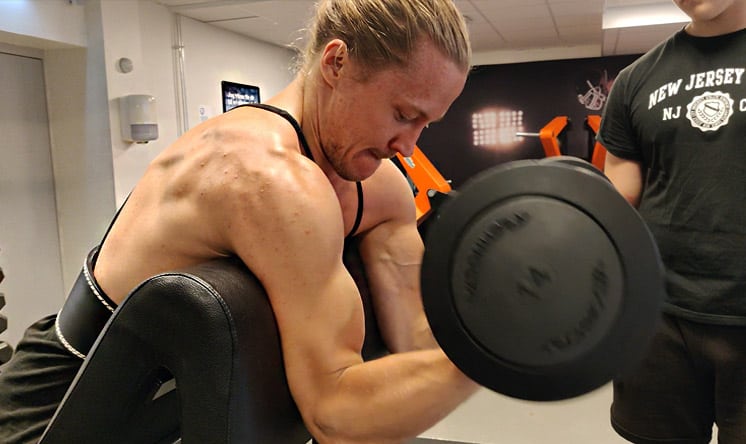
Rear delt flyes:
This is one of the only machine exercises that I like. You can do rear delt flyes with dumbbells as well, but I prefer machine since I feel it target my rear delts better while dumbbells have a tendency to target a lot of other muscles on the back more.
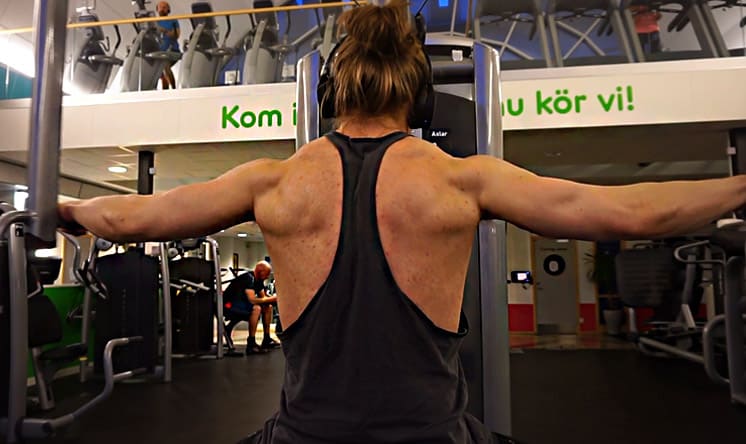
Myo Reps For Abs
The final reason for using Myo reps is to build your six pack! But, now you might ask; isn’t my abs made in the kitchen?
Here’s the thing:
Abs are revealed in the kitchen, but just as with any other muscle, they’re built in the gym.
Now, heavy compound lifts will train your abs. But they will mainly train your internal, stabilizing abs, such as your transverse abdominis, and your internal obliques.
To get that six pack to really pop when you’re lean, you must train your rectus abdominis directly, which is done with ab flexion exercises, such as crunches, and leg raises for example. The abs are also very fatigue resistant and hence that responds very well to Myo reps!
Best exercises for abs:
Hanging leg/knee raises:
To build the six pack I definitely recommend hanging leg raises or knee raises. These exercises target your whole rectus abdominis from the top to the bottom completely, while also giving a bit of training for other muscle groups included in the abs and hips as well.
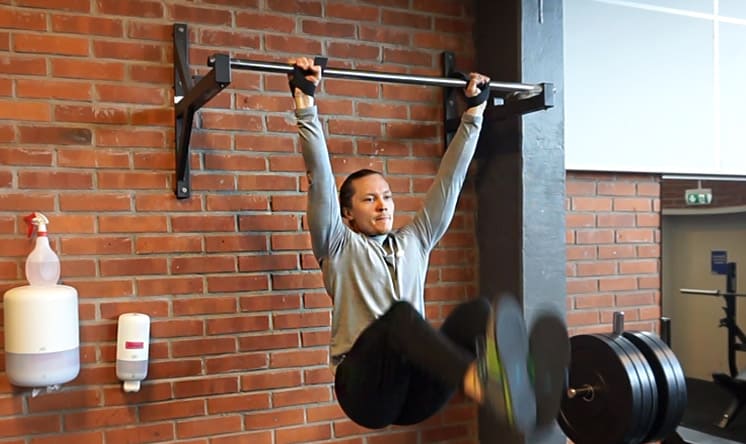
When doing hanging leg raises you can keep a slight bend in the knees while trying to use your core to lift your legs all the way up until your feet touches the bar.
If you can’t do hanging leg raises yet, then start with hanging knee raises where you try to reach your elbows with your knees. Your goal is to do strict hanging knee raises for 15 reps + the Myo mini sets. Once you’re able to do this you’ll have a strong and sexy looking core!
How to Use Myo Reps When Plateaued/Stalled
Just as I touched on earlier in the article, using Myo reps when you’ve stalled with your strength training is a great idea. The reason for this was as I said because of monotonous overtraining where you’ve gotten a maladaptation of the neuromuscular system from doing the same exercises in the same fashion for long periods of time.
The best way to break out of this kind of plateau is either to take a deload of the exercise/muscle group you’ve plateaud on. A deload typically means reducing the volume and intensity to around half for 1-2 weeks. This obviously means that you’re taking a complete break from overloading training and will just maintain your gains during this time.
You can read more about breaking through a plateau here.
Now, sometimes a better thing to do would be to use a period of Myo reps instead of taking a complete deload. This way you’d still get a great stimulus for growth but you’d also get rid of the monotonous overtraining syndrom at the same time.
This is known as periodization and it can work incredibly well in order to move you into new strength levels and pack on tons of new muscle mass. With that said, this seems to become increasingly more important the more advanced you become. So, during your beginner to early intermediate years, the chance of a plateau on your big compound lifts are relatively small if you’re training correctly.
Conclusion – Myo Reps
Myo reps is a great method to use mainly for assistance exercises.
I’ve found that the best use of Myo reps is for my side delts, since they don’t get targeted well with heavy strength training.
It’s also a great method for adding extra volume to muscle groups that often require more volume to grow, such as most people’s rear delts, biceps and abs. And I’ve also found that calves grow incredibly well with Myo reps, but how many of us wants to train calves, right?! 🙂
Finally, implementing Myo reps when plateaued can help you break through the plateau without having to take deload periods where you’re not making any gains for some time.
What’s Next
Obviously, the use of Myo reps and assistance exercises is just the top of the ice berg when it comes to building an aesthetic looking physique. If you want to know exactly what to do depending on your starting point and goal physique, then I recommend that you read my free guide; how to build an aesthetic physique. You can get to the guide by clicking here!

Explained brilliantly!
Thank you!
No mention here of how many exercises per body part.
No example weekly plan.
No mention of how many body parts trained per week
How many weeks would you use it? Or is it a normal method you use?
I use it normally on all my isolation exerices mostly year around. However, I’ve seen that some people do well by incorporating MYO reps for about 6-8 weeks and then do 6-8 weeks with a more standard approach. There’s some evidence that techniques such as Myo reps are very taxing and hence that people do well by cycling of them once in a while. But, I’m not sure though, more evidence needs to come out.